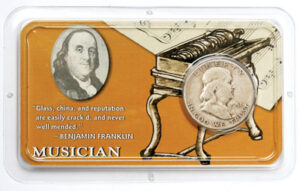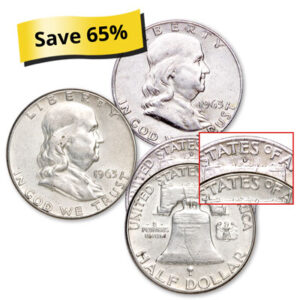Franklin & the Other Mrs. Ross
Mention Franklin and Ross in the same sentence, and the young widow who stitched an early version of the American flag, Betsy Griscom Ross, leaps to mind. After all, both lived in Philadelphia as the colonies launched their daring bid for independence.

But Benjamin Franklin was more closely linked to a different widowed Ross. True to the popular phrase, “Behind every great man there’s a great woman,” Nellie Tayloe Ross issued a bold directive about America’s first Renaissance man. Together, in 1948, they changed coinage history. Yet, 75 years later, few people know her name.
So, who was this Mrs. Ross?
Call it irony. Or, call it fate. In 1876, the centennial year of America’s freedom, Nellie Tayloe was born in St. Joseph, MO. A couple of family moves to Kansas and then Nebraska saw her graduate from high school, get an instruction certificate, and start teaching kindergarten. At a family reunion in Tennessee in 1900, she met lawyer William Bradford Ross. Two years later, she married him, then followed her ambitious spouse to Wyoming, had three sons, and involved herself in civic life.
In 1922, Ross was elected governor. Tragically, 21 months later, he died from complications following an appendectomy. The Democratic Party nominated his widow to fill his position in a special election. When she won, Nellie Tayloe Ross became the first woman elected governor in the United States. In fact, back in 1869, Wyoming’s territorial legislature had passed a law granting women the right to vote. It was a decision that would later inspire the state motto.

She was narrowly defeated for re-election, but remained active in national politics – so much so that newly elected President Franklin D. Roosevelt appointed her director of the U.S. Mint. In 1933, Nellie Tayloe Ross became the first woman to hold that position.
A decade of design changes
Within five years, Ross started to oversee two notable changes in coin designs. The first was the decision to replace the nickel’s Native American obverse with a profile of third president Thomas Jefferson; the buffalo reverse with Jefferson’s Virginia home, Monticello. In October of 1938, the new five-cent piece went into production.
There were no coin design changes as the U.S. entered WWII in 1941. But, just a few short weeks before victory could be declared in Europe in 1945, FDR died. Ross helped shepherd the dime’s new design into production that honored her political patron. The Roosevelt ten-cent piece debuted on what would have been his 64th birthday on January 30, 1946.
Primed by the process of how changes in coin designs came about, Nellie Tayloe Ross herself championed a new half dollar design. Hers featured two daring choices. For the obverse: A man, not a mythical vision of the Roman goddess, Liberty. And a non-president!

Franklin, a Founding Father, was a true polymath – that is, an individual with wide-ranging knowledge and a thirst for learning. He was a writer, printer, scientist, economist, philosopher, musician, plus the nation’s first postmaster and a designer of early American paper money in which he used the curlicues found in nature to foil counterfeiters.
On the reverse? The bell that rang Philadelphia’s patriots to hear the first public reading of the Declaration of Independence. One of its co-writers and signers was the Boston-born Franklin, an adopted son of the City of Brotherly Love. To fulfill a legal requirement that half dollars depict the figure of an eagle, a small one was placed to the right of the iconic bell.
“[A coin] must have meaning.… it must tell a worthwhile story in its symbolism and historic suggestion…For several years I had harbored the hope that during my tenure in the Mint these two features might be incorporated in a design…I believe, that the 50-cent piece, being larger, and of silver, lends itself much better to the production of an impressive effect.”
Undeterred by criticism
On April 29, 1948, Mrs. Ross attended a private unveiling of the new half dollar at the Franklin Institute in Philadelphia. Invited dinner guests were said to have received the new Franklin half struck in 90% fine silver in a place card signed by the U.S. Mint director.
“Any alteration in the physical aspect of one of our coins is quite a serious responsibility,” she told the 200 assembled. “Most people probably pay little attention to the details of any of them, but let an innovation be proposed and it becomes, at once, a matter of intimate, personal interest to almost everybody.”
Five months earlier, Gilmore Clarke, chair of the Commission of Fine Arts, wrote to Mrs. Ross, expressing disapproval with the Franklin half dollar’s reverse design. His concerns were over the eagle’s small size and a worry that the bell’s infamous crack “might lead to puns and to statements derogatory to United States coinage.”
Undeterred, Mrs. Ross stayed her course. In her banquet speech on the eve of the half dollars release into mass circulation, she said:
“To me [the Liberty Bell] is a soul-stirring thought that on this coin it will go out to the four corners of our country into the hands of practically every American…I express the ardent hope that it may be a constant reminder to us all how blest we are to lived [sic] in this land of liberty…”
Ultimately, the Franklin half dollar series would run through 1963, and be the last silver half dollar series from the U.S. Mint, owing to the price spike for silver in the precious metals market. By then, Mrs. Ross was 10 years into retirement as mint director. She lived out her days in Washington, D.C., passing away in 1977 at the age of 101. Just as this Mrs. Ross has vanished from most history pages, so her Franklin half dollars have disappeared from circulation. If you want to know how you can collect these increasingly hard-to-find silver halves, please visit Littleton Coin’s Franklin Half Dollar Club.
SOURCES:
Alter, Charlotte. “What We Can Learn from Nellie Tayloe Ross, America’s First Female Governor.” Time, November 4, 2014. https://time.com/3555677/nellie-tayloe-ross/
LaMarre, Tom. “The Franklin Half Dollar.” Rare Coin Review: Bowers & Merena, Inc.: Wolfeboro, NH. Issue No. 69, pp. 46-48.
Lewallen, Ryan. “Women’s History Month: Wyoming elect first women governor” Accessed June 2, 2023 https://county17.com/2023/03/04/womens-history-month-wyoming-elects-first-woman-governor-in-u-s-history/?amp=1
Rea, Tom. “The Ambition of Nellie Tayloe Ross.” Accessed June 2, 2023. https://www.wyohistory.org/encyclopedia/ambition-nellie-tayloe-ross





Wow, another amazing tidbit of history I’d never heard – the two Ross women certainly played roles significant to public aspects of the United States. And I sure never knew there was a rule about having the eagle on there, regardless of anything else. Great trivia!
Our Chairman, David Sundman, has always been fond of saying “Coins are history you can hold in your hand!” and this story is just an example of how true that is! The back stories surrounding US coins & paper money are fascinating and unfortunately often not very well known. Thanks for stopping by & for your comments. Happy New Year!